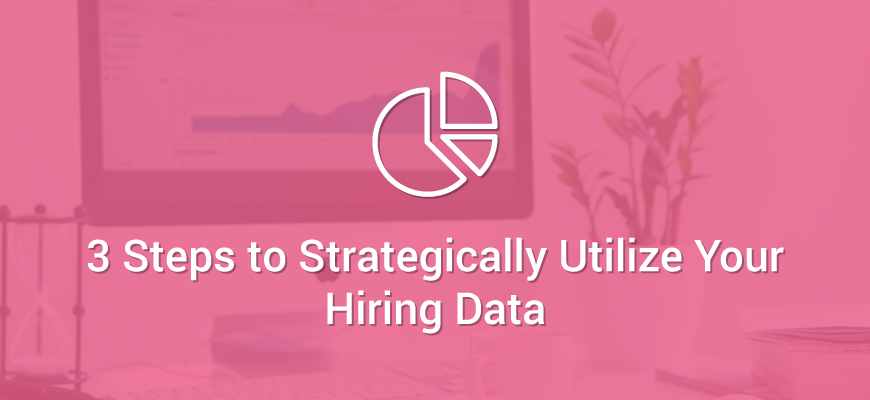Data now informs every business decision — hiring not excluded. In fact, LinkedIn’s 2018 Global Recruiting Trends report found 79 percent of recruiting and HR pros are at least ‘somewhat likely’ to use hiring data in the next two years.
However, 14 percent are unsure how to use it, 20 percent are unsure where to get it, and 42 percent believe their data is poor-quality.
To help you properly collect and use hiring data throughout your process, we turned to the experts:
1. Determine your approach to hiring data
 The common debate is whether hiring professionals should take a “mechanical” or “clinical judgment” approach in combining data points to make a decision.
The common debate is whether hiring professionals should take a “mechanical” or “clinical judgment” approach in combining data points to make a decision.
The mechanical approach consists of the combination of data to develop a formal algorithmic, objective procedure (e.g., an equation) to reach a decision. This is typically the approach taken when you read about the use of “big data” or “artificial intelligence” in selection.
The clinical judgment approach typically relies on human judgment that is based on information contemplation and, sometimes, discussion with others in a group consensus meeting. A good example of this may be a recruiter looking at a resume, LinkedIn profile, or other digital data gathered in a Google search on a candidate or a hiring manager conducting an interview.
The argument for the mechanical approach is there is less bias in the hiring process, and the objective nature of the process should result in better prediction of job performance (assuming the data plugged into the algorithm is a valid predictor of job performance for the targeted job).
The clinical judgment approach is often used because recruiters and hiring managers in particular feel they can identify the best candidates based on their personal experience and expertise. Another way to put it is “hiring managers don’t need no stinking data.”
The research and my personal experience would suggest the clinical approach can be dramatically improved if individuals are trained on how to use the data.
Jamie Winter, VP Consulting and Hiring & Promotion Practice Leader at APTMetrics
2. Identify KSAOs and map them to your hiring process
Start by clearly defining what is important to be successful on the targeted job. Typically, this is determined by conducting a job analysis. The outcome of the job analysis typically is a list of knowledge, skills, abilities and other characteristics (KSAOs) for a given job or role. Note that sometimes organizations will use competencies as another term for KSAOs.
Next, design your selection process. In other words, what are you going to measure, how are you going to measure it, and how will you combine the data you gather to make selection decisions? The design will be based on your parameters for the selection process (e.g., cost, people involved, timing, technology, etc.).
You also want to consider which KSAOs you want to measure in your selection process and which ones on which you can train new hires. In the end, you want to create a process that measures your targeted KSAOs in the most valid, cost-effective, efficient, fair, and candidate-friendly process possible.
Build a coverage grid that maps your process to the targeted KSAOs. This grid will tell you which selection tool/step in the process will measure which targeted KSAO/competency and the data gathered from each tool.
Jamie Winter
3. Calculate metrics to improve overall business outcomes
 Successfully utilizing these five metrics and translating them into actions will help drive more successful business outcomes from your hiring processes:
Successfully utilizing these five metrics and translating them into actions will help drive more successful business outcomes from your hiring processes:
Cost-Per-Hire (CPH): Knowing this number can help make wiser investment decisions, outline referral bonuses, and save the company money over time. On average, cost-per-hire is $4,129. Recruiters should be responsible for matching or beating internal CPH.
How to calculate: (External Costs) + (Internal Costs) / Total Number of Hires in a Time Period
Time to Hire: This metric is the amount of time it takes to fill a position, the average is 42 days.
How to calculate: (Date Hired) – (Date Posted)
Turnover Rate: When a company has a high employee turnover rate, it undoubtedly hurts the bottomline. Companies should keep an eye on employees leaving the organization so they can analyze, and hopefully minimize, causes of turnover.
How to calculate: (Number of Separations Per Year) / Avg. Number of Employees Per Year) x 100
Turnover Cost: If turnover rate is high or increasing, so is turnover cost. There are other non-monetary costs that turnover effects as well, such as decreasing employee engagement, lowered employee morale, and an increase in work gossip.
How to calculate: Total Cost of Separation + Vacancy + Replacement + Training
Absence Rate: Paid time off (PTO) costs employers between 20.9% and 22.1% of their total payroll. The high price tag on employee absence affects companies even more when lost productivity, employee morale, and impermanent labor costs are measured.
How to calculate: [(Number of Days Absent in Month) / (Avg. Number of Employees in Month) x (Workdays)] x 100











